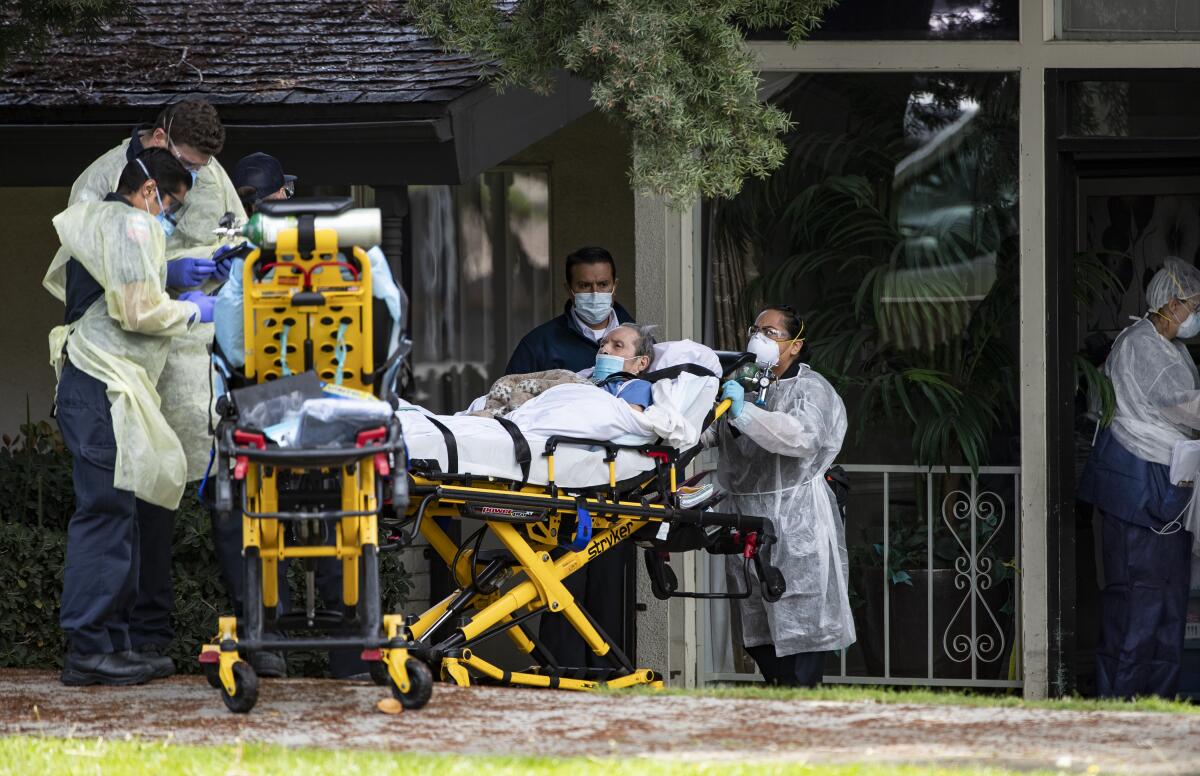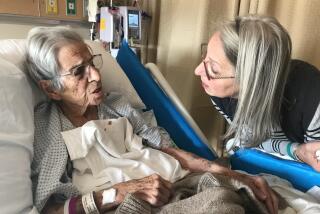Hospices, coping with coronavirus pandemic, are scrambling for supplies too

As deaths from COVID-19 mount across the country, a chronic shortage of personal protective equipment has heightened fears for the safety of hospital doctors and nurses who play a critical role in saving lives.
But similar challenges are confronting another important but less visible segment of the U.S. healthcare system: hospice workers who keep dying people comfortable at life’s end.
Nurses, chaplains and other hospice workers who tend to the terminally ill routinely visit patients in their homes or in nursing facilities, putting themselves at risk of contracting the virus or becoming vectors.
Like hospitals, some hospice providers have been desperately soliciting donations of masks, gowns and other supplies from the public and local businesses forced to close by official stay-at-home orders.
At the same time, concerns over the shortage of equipment and recently restricted access to many nursing homes have led some hospices to forgo personal visits by their workers in favor of video conferencing, a move that some advocates for patients’ rights fear could keep the dying from receiving the personal care they need in their last days.
Edo Banach, president and chief executive of the National Hospice and Palliative Care Organization, said hospices had not yet seen a wave of COVID-19 patients, but others who are seriously ill or dying are being discharged from hospitals to make way for them.
Many of them require hospice care, he said, and their numbers are likely to grow.
“ ‘Sorry, we are going to need that bed now’ is definitely a dynamic going on” at some hospitals, Banach said, warning that hospice capacity could be limited, and patients’ lives put at risk, by a lack of protective gear.
“We can’t act as a safety valve for hospitals and nursing homes if we can’t protect our people,” he said. “And we can’t be spreading disease from house to house — that would be awful.”
On the Nextdoor website, Khyla Hislop, community liaison director for Cadence Hospice in Orange County, recently pleaded for help from local businesses that were ordered to close or limit operations during California’s state of emergency, including restaurants, nail salons, automotive shops and hairdressers.
“We are asking for donations of gloves, masks, goggles of any kind that you may have that are not being used,” she said. “Even a one-box donation can help us better protect our clinical and caregiver staff as we service our community in need.”
As the U.S. population has aged, the number of hospice providers has ballooned over the last two decades to about 4,700 nationwide, with nearly a quarter of those in California.
Medicare now spends more than $19 billion a year for services for some 1.5 million hospice beneficiaries, who receive physician and nursing services, prescription drugs, home medical equipment, supplies and spiritual counseling.
Some terminally ill patients are treated in stand-alone hospice units, but the vast majority are cared for in their homes, nursing facilities or senior living communities.
Jan Jones, chief executive officer of the California Hospice Network, a coalition of nonprofits, said the pandemic was “having an impact” on providers, especially those with patients in nursing homes.
“Most nursing homes are still allowing nurses to visit, as long as they are not sick themselves,” she said, noting that hospice workers’ temperatures are routinely taken before they’re allowed to enter.
Like other healthcare workers, Jones said, hospice doctors, nurses and home health aides are dealing with the emotional strain of worrying that they will contract the coronavirus themselves.
The public should realize that COVID-19 cases are likely to rise when stay-at-home orders are eased, officials said.
Jones, who is also CEO of the Elizabeth Hospice in San Diego County, said she expected that any uptick in demand probably wouldn’t be because of COVID-19 patients being released from the hospital.
She said it probably would be driven by the spread of the disease among people who were already terminally ill, including those who would not benefit from treatment in hospital intensive care units or who preferred to stay at home.
In any case, she said her hospice — which has a staff of 300 and treats about 500 patients — and others in the nonprofit coalition were committed to accepting coronavirus patients who qualified, including having been diagnosed with six months or less to live.
“We will care for anyone who is terminally ill and meets the eligibility requirements of Medicare,” she said.
Hospice care also involves nonmedical visits by chaplains and social workers, Jones and others said, and those are now mostly done by videoconferencing, such as with Skype and FaceTime.
In response to the pandemic, the Centers for Medicare and Medicaid Services, which oversees hospice care at the federal level, last month expanded the allowable use of telemedicine to cut down on personal interaction.
“With the emergence of the virus causing the disease COVID-19, there is an urgency to expand the use of technology to help people who need routine care, and keep vulnerable beneficiaries and beneficiaries with mild symptoms in their homes while maintaining access to the care they need,” the agency said in updating its guidance.
The virtual visits must have both audio and video capabilities, according to the guidelines.
Some smaller hospices in Los Angeles County are now dealing with patients almost exclusively by smartphone, said Carmen Cordero, who has been a consultant to more than a dozen providers.
“With telehealth we can call the patient and find out how they are doing and document it,” she said. “The reason why we don’t go [in person] is also because we want to make sure we are protecting the patients, who are vulnerable people, and keeping them safe from infection.”
Michael Connors, a long-term-care advocate with California Advocates for Nursing Home Reform, said he was concerned about the loss of direct care, citing reports of some nursing homes refusing to allow hospice workers in.
“Family members don’t even know what’s going on in nursing homes because they are locked out,” he said.
“Hopefully, direct caregivers are still coming in and seeing patients and providing direct care to hospice patients,” Connors said. “They don’t need any less care.”
Palliative care doctors, who treat not only terminally ill patients but also others with life-limiting serious illnesses such as cancer and dementia, say the prospect of a patient surge is complicating their practices, too.
For example, a 90-year-old with a urinary tract infection who might have been admitted to the hospital before the pandemic could now be sent home with antibiotics to keep that bed open for a patient who needs it more urgently, said Dr. Angela Yeh, a Los Angeles palliative care specialist.
Such decisions are prompting heart-to-heart conversations with their patients about what treatments they want — or don’t want — Yeh said.
At a time when ventilators are in scarce supply for coronavirus patients, some other seriously ill patients might wish to forego such aggressive treatment if their chances of recovery are not good anyway, she said.
“When you are in the calm before the storm, you have to do everything you can to talk to the patient and family members, especially if they are high risk,” Yeh said. “It is really important for us to know what is meaningful and valuable to that person.”
More to Read
Start your day right
Sign up for Essential California for news, features and recommendations from the L.A. Times and beyond in your inbox six days a week.
You may occasionally receive promotional content from the Los Angeles Times.








